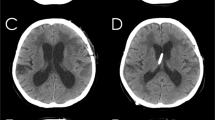Abstract
Objective
The aim of this prospective study was to analyze the changes in cerebrospinal fluid (CSF) distribution after endoscopic third ventriculocisternostomy (ETV).
Methods
Twenty-two hydrocephalic children (eight boys, aged 3 months to 17 years) candidates for ETV were studied by preoperative brain magnetic resonance (MR) and repeated post-ETV MRs at established time intervals. A volumetric analysis of CSF distribution after ETV was performed using a specific software.
Results
Fifteen children had an uneventful follow-up, whereas four required a second ETV due to a secondary closure of the stoma, one died of acute intracranial hypertension, and two needed an extrathecal shunt. A progressive reduction in the volume of the ventricles was found in case of successful ETV during the follow-up period. The ventricular volumes were reduced in average of 76 % of the initial volume at day 3, 69 % at 2 weeks, 42 % at 2 months, and 40 % at 6 months. This finding was associated with an enlargement of subarachnoid spaces which increased in case of successful ETV (192 % of initial volume at day 3; 210 % at day 15; 428 % at 2 months; and 468 % at 6 months). In case of secondary closure of the stoma, the distribution of intra- and extraventricular CSF tended to go back to the preoperative status.
Conclusion
Volume variations of the ventricles and the subarachnoid spaces are a good indicator of the efficacy of the ETV.





Similar content being viewed by others
References
Goumnerova LC, Frim DM (1997) Treatment of hydrocephalus with third ventriculocisternostomy: outcome and CSF flow patterns. Pediatr Neurosurg 27(3):149–152
Nishiyama K, Mori H, Tanaka R (2003) Changes in cerebrospinal fluid hydrodynamics following endoscopic third ventriculostomy for shunt-dependent noncommunicating hydrocephalus. J Neurosurg 98(5):1027–1031
Feng H, Huang G, Liao X, Fu K, Tan H, Pu H, Cheng Y, Liu W, Zhao D (2004) Endoscopic third ventriculostomy in the management of obstructive hydrocephalus: an outcome analysis. J Neurosurg 100(4):626–633
Erşahin Y, Arslan D (2008) Complications of endoscopic third ventriculostomy. Childs Nerv Syst 24(8):943–948
Kadrian D, van Gelder J, Florida D, Jones R, Vonau M, Teo C, Stening W, Kwok B (2005) Long-term reliability of endoscopic third ventriculostomy. Neurosurgery 56(6):1271–1278
Navarro R, Gil-Parra R, Reitman AJ, Olavarria G, Grant JA, Tomita T (2006) Endoscopic third ventriculostomy in children: early and late complications and their avoidance. Childs Nerv Syst 22(5):506–513
Drake JM (2007) Canadian Pediatric Neurosurgery Study Group. Endoscopic third ventriculostomy in pediatric patients: the Canadian experience. Neurosurgery 60(5):881–886
Xenos C, Sgouros S, Natarajan K (2002) Ventricular volume change in childhood. J Neurosurg 97(3):584–590
Bargalló N, Olondo L, Garcia AI, Capurro S, Caral L, Rumia J (2005) Functional analysis of third ventriculostomy patency by quantification of CSF stroke volume by using cine phase-contrast MR imaging. AJNR Am J Neuroradiol 26(10):2514–2521
Buxton N, Turner B, Ramli N, Vloeberghs M (2002) Changes in third ventricular size with neuroendoscopic third ventriculostomy: a blinded study. J Neurol Neurosurg Psychiatry 72(3):385–387
Kulkarni AV, Drake JM, Armstrong DC, Dirks PB (2000) Imaging correlates of successful endoscopic third ventriculostomy. J Neurosurg 92:915–919
Schwartz TH, Ho B, Prestigiacomo CJ, Bruce JN, Feldstein NA, Goodman RR (1999) Ventricular volume following third ventriculostomy. J Neurosurg 91(1):20–25
St George E, Natarajan K, Sgouros S (2004) Changes in ventricular volume in hydrocephalic children following successful endoscopic third ventriculostomy. Childs Nerv Syst 20(11–12):834–838
Preul C, Tittgemeyer M, Lindner D, Trantakis C, Meixensberger J (2004) Quantitative assessment of parenchymal and ventricular readjustment to intracranial pressure relief. AJNR Am J Neuroradiol 25(3):377–381
Cinalli G, Sainte-Rose C, Chumas P, Zerah M, Brunelle F, Lot G, Pierre-Kahn A, Renier D (1999) Failure of third ventriculostomy in the treatment of aqueductal stenosis in children. J Neurosurg 90(3):448–454
Author information
Authors and Affiliations
Corresponding author
Rights and permissions
About this article
Cite this article
Di Rocco, F., Grevent, D., Drake, J.M. et al. Changes in intracranial CSF distribution after ETV. Childs Nerv Syst 28, 997–1002 (2012). https://doi.org/10.1007/s00381-012-1752-6
Received:
Accepted:
Published:
Issue Date:
DOI: https://doi.org/10.1007/s00381-012-1752-6




